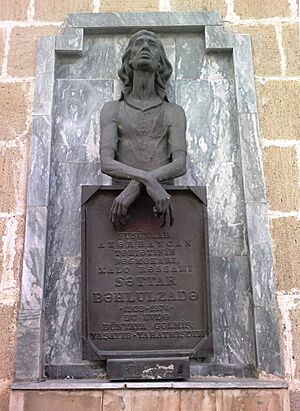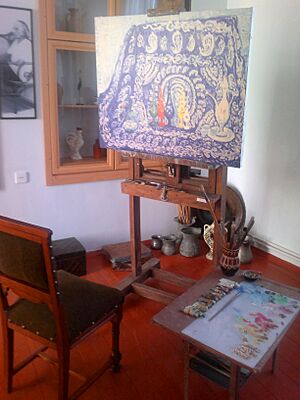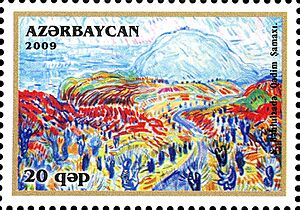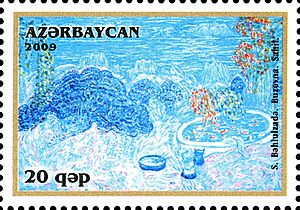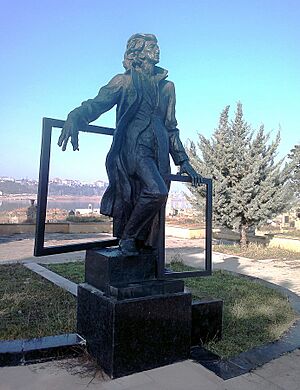Sattar Bahlulzade facts for kids
Quick facts for kids
Sattar Bahlulzada
|
|
|---|---|
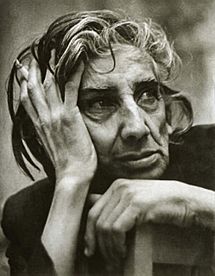 |
|
| Born |
Səttar Bəhlul oğlu Bəhlulzadə
15 December 1909 |
| Died | 14 October 1974 (aged 64) |
| Nationality | Azerbaijani |
| Known for | Landscape art, Portrait painting, Still life, History painting |
| Movement | Impressionism, Neo-Impressionism |
| Awards | |
Sattar Bahlulzade (Azerbaijani: Səttar Bəhlulzadə) was an amazing Azerbaijani painter. He was born on December 15, 1909, and passed away on October 14, 1974. He is most famous for his beautiful landscape paintings that show the nature of Azerbaijan. Many people see him as the person who started Impressionism in Azerbaijan.
Some of Bahlulzade's most well-known paintings include Tears of Kapaz (1965) and Bank of the Gudiyalchay (1953). Other famous works are Dream of the Land (1961), Evening Above the Caspian Sea (1959), and Goygol (1964). His art has been shown in exhibitions in Azerbaijan, the Soviet Union, and other countries around the world. Most of his paintings are kept in the National Art Museum of Azerbaijan. There is even a special room there just for his art. Some of his paintings are also in museums in Moscow, Tbilisi, and Beijing.
Today, Sattar Bahlulzade is thought to be one of the greatest painters from Azerbaijan. He is also a very important person in the history of Azerbaijani art. He received many awards, including two Orders of the Red Banner of Labour. He was also named a People's Artist of Azerbaijan.
Contents
Early Life and Art Training
Sattar Bahlulzade was born on December 15, 1909. His birthplace was the village of Amirjan, which is close to Baku. He was the third child in his family, with two older sisters. Sattar loved painting from a very young age. When his father bought him colored pencils, Sattar drew everything he saw. He drew the Novruz holiday, special dances, and children jumping over bonfires.
Sattar grew up surrounded by beautiful folk art. His mother and grandmother wove colorful carpets. His family also had lovely jewelry, ceramics, and copper dishes. All these things helped him develop a love for art. He once wrote in his diary: "Everything had its own special place in the house. Mother arranged the dishes like an artist. She folded the blankets and beddings in a way that the color schemes matched. For her, it was a work of art, it was beauty."
At school, Sattar enjoyed reading poems by famous writers like Nizami Ganjavi and Fuzuli. He especially loved the characters from Fuzuli's poem Layla and Majnun. He would draw these characters on his notebooks. His teachers were very impressed with his drawings. One teacher told him, "there is only one path forward for you, Sattar, and that is to become an artist." His music teacher was the famous composer Muslim Magomayev.
Sattar started studying at the National Art Institute in Baku in 1927. After finishing in 1931, he worked as an illustrator. He drew cartoons for a newspaper called "Communist." His first published artworks were these cartoons.
In 1933, he went to study at the Moscow School of Painting, Sculpture and Architecture. There, he learned from a teacher named Vladimir Favorsky. It was at this school that Sattar became very interested in landscape painting. He often took summer trips to Crimea. These trips helped him become a master at painting landscapes. He realized that painting was truly what he was meant to do.
A Career in Art
When Bahlulzade returned to Baku, he first focused on painting historical people and events. In 1941, he joined the Artists' Union of the USSR. After World War II, he started painting scenes of the oil fields, country houses, and villages. These were all located on the Absheron Peninsula. Sattar became more and more drawn to painting nature. He began to create more landscape scenes.
Bahlulzade was known mostly for his landscape paintings. They showed the beautiful nature of Azerbaijan. He often went out into nature to paint what he saw. He wanted to capture all its beauty on his canvas. Bahlulzade once said: "I don't have to go to Tahiti, like Gauguin, for inspiration, and I do not advise others to do it. The life and land of your people - they are the true sources of inspiration."
At first, Sattar painted nature in a realistic way, just as his teachers had taught him. But soon, he developed his own special style. This new style helped him show his feelings about nature much better. His new way of painting was more dreamlike and even cosmic. Some of his works look like satellite photos of Earth. He used soft colors mixed with bright, bold ones. He also used strong brushstrokes. This made his nature paintings more colorful and lively. Sometimes, he even added fantastic elements.
From the late 1940s, Bahlulzade started creating his most famous artworks. These include The Bank of Qudyalchay and The Road to Gizbanovsha (1953). Other well-known works are Golden Evenings (1955) and Native Lands (1957). In these landscapes, he used a very rich color palette. This made his paintings look very decorative and full of color.
Sattar Bahlulzade painted both natural and industrial landscapes at the same time. This was important to him. He understood the beauty of oil drills, which he had seen since he was a child. In 1954, he visited the Oil Rocks offshore drilling complex. People called it the Island of Miracles back then. He was immediately amazed by it. Sattar drew many sketches there. He returned to Baku full of new ideas for paintings about the oil industry. This led to paintings like Spring Morning in Baku (1959) and Evening Above the Caspian Sea (1959).
In 1973, a year before he passed away, Bahlulzade had a special exhibition in Moscow. The newspapers in Moscow wrote about it. They said that people in Russia truly appreciated Sattar Bahlulzade's art after this show. They described the exhibition as "stunning" and "a feast of colors and light." They felt that before Sattar, they had not known how beautiful Azerbaijan was.
Later Life and Passing
In 1973, Bahlulzade became very ill. He was being treated in a hospital in Baku, but he was not getting better. The doctor told him he needed to go to Moscow for more treatment. However, officials would not pay for his trip. So, his friends helped him go to Moscow.
Sattar Bahlulzade passed away in Moscow on October 14, 1974. He was buried on October 16. Instead of being buried in the main cemetery in Baku, he was buried in his home village of Amirjan. This was his wish, so he could be next to his mother's grave. A monument was placed on his grave. It was made by sculptor Omar Eldarov. The monument shows an artist with two empty picture frames.
His Unique Style
Bahlulzade truly loved nature and felt like he was a part of it. He spent most of his life outdoors. He wanted to be close to nature to understand it and paint it exactly as it was. As a painter, Sattar Bahlulzade felt he could express himself best when he was in harmony with nature. You can see this in the backgrounds of many of his famous paintings. He spent a lot of time working on each piece.
However, he did not paint any winter landscapes. Nature in winter did not attract him as much. During the colder months, he mostly painted in his studio. There, he created new paintings based on his memories from summer.
It took him much effort to capture nature. Sattar knew this. He once said:
“Many people think that I can take a clean canvas and a paintbox and easily paint various moments in nature whenever I wish. They are wrong. This is not the case at all. I have always had a habit: most of the time, I first draw sketches for my pictures. Sometimes I do not draw sketches but keep them in my memory. For instance, the landscape "Tears of Kapaz" is drawn from memory. I did not draw any sketch for it. I had no opportunity to do that at the time anyway.
I remember my visit to Goygol together with Tahir Salahov and Togrul Narimanbekov. I woke up early in the morning and looked around. The sun was just rising. In the dawn, Kapaz [mountain] looked unusual to me. I cried out instinctively, waking Togrul and Tahir. They joined me where I was standing, and we looked at the unusual scene. None of us said a word or did anything. But I remembered that sight with all its brightness and mood. I copied that scene onto the canvas upon my return to Baku and called it The Tears of Kapaz. Togrul and Tahir were astonished when they saw the picture.
We have seen many pictures of Goygol so far. Of course, you can draw pictures of a thing or place many times. This is not very dangerous because every painter has his own approach and attitude to an object. What is most important is that a painter has to have his own creative view, his own fantasy, and creative thinking so that he does not look like others or repeat what other people have already done.”
His Personality
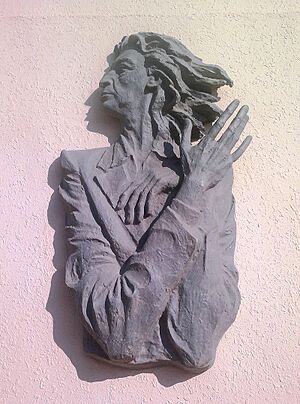
For most of his life, Sattar Bahlulzade lived in his home village. He rarely went to the city to see friends or family. He never married and did not have much of a personal life outside of his art. Sattar was known for being very generous. He often gave his paintings away as gifts.
Sometimes, people from other countries who loved art would visit his studio. Once, a guest from Italy wanted to buy one of his paintings. But Sattar decided to give it to him for free. When the guest said he couldn't take such a valuable gift without paying, Sattar replied, "I never give cheap gifts."
In 1964, Bahlulzade's paintings were shown in the National Gallery in Prague. After the exhibition, the museum wanted to buy five of his paintings for their collection. But Sattar refused the money. He offered the paintings to the gallery as a gift instead. These stories show that he did not care much about money or material things. He even smoked the cheapest cigarettes.
Sattar had some unique features, like his long hair. People say he only cut his hair twice in his whole life. The first time was when the Azerbaijani sculptor Fuad Abdurakhmanov wanted to make a sculpture of him. Bahlulzade thought Fuad might focus more on his hair than his personality. So, he cut his hair before going to the sculptor's studio. Abdurakhmanov was very surprised! Today, that marble sculpture is in the National Art Museum of Azerbaijan in Baku. It shows the artist with short hair.
His Lasting Impact
Bahlulzade's artworks have been shown in many countries. These include Algeria, Egypt, Lebanon, Syria, Tunisia, Norway, Germany, Czechoslovakia, Bulgaria, Hungary, Romania, Iraq, Cuba, Canada, Belgium, France, and Japan. Most of his paintings are kept in the National Art Museum of Azerbaijan. They are also in museums in Moscow, Tbilisi, Yerevan, and Beijing. At the National Art Museum of Azerbaijan, Bahlulzade's paintings are in their own special room. President Heydar Aliyev visited this room in 1994 to celebrate Sattar's 85th birthday.
Bahlulzade received many awards and titles. These include the Order of the Red Banner of Labour (1959) and being named an Honored Artist of the Azerbaijan SSR (1960). In 1963, he became a People's Artist of the Azerbaijan SSR. He received the Order of the Red Banner of Labour again in 1969. In 1972, Sattar Bahlulzade won the State Prize of the Azerbaijan SSR. This was for his series of paintings called Landscapes of Azerbaijan.
A street in the Surakhani district of Baku is named after Bahlulzade. A community center in his home village, Amirjan, also carries his name. Many documentaries, paintings, poems, and sculptures have been made about Bahlulzade's life and work. On his 100th birthday in 2009, a new series of postage stamps was released. These stamps, called Azerbaijani School of Fine Arts: Artist S. Bahlulzade, show six of his beautiful paintings.
Images for kids
See also
 In Spanish: Sattar Bahlulzade para niños
In Spanish: Sattar Bahlulzade para niños


